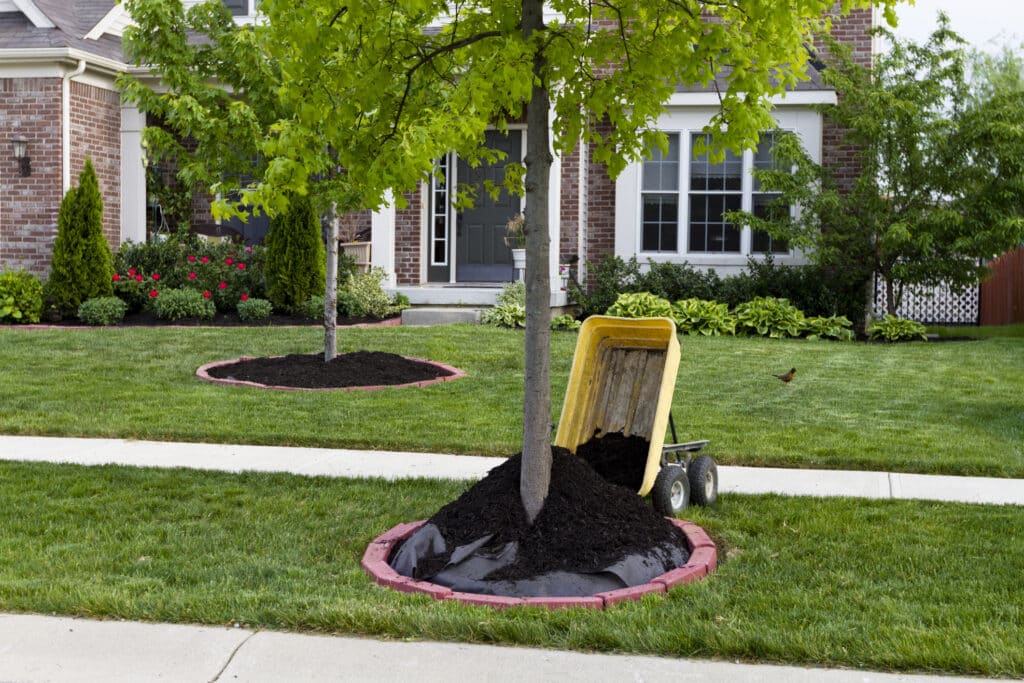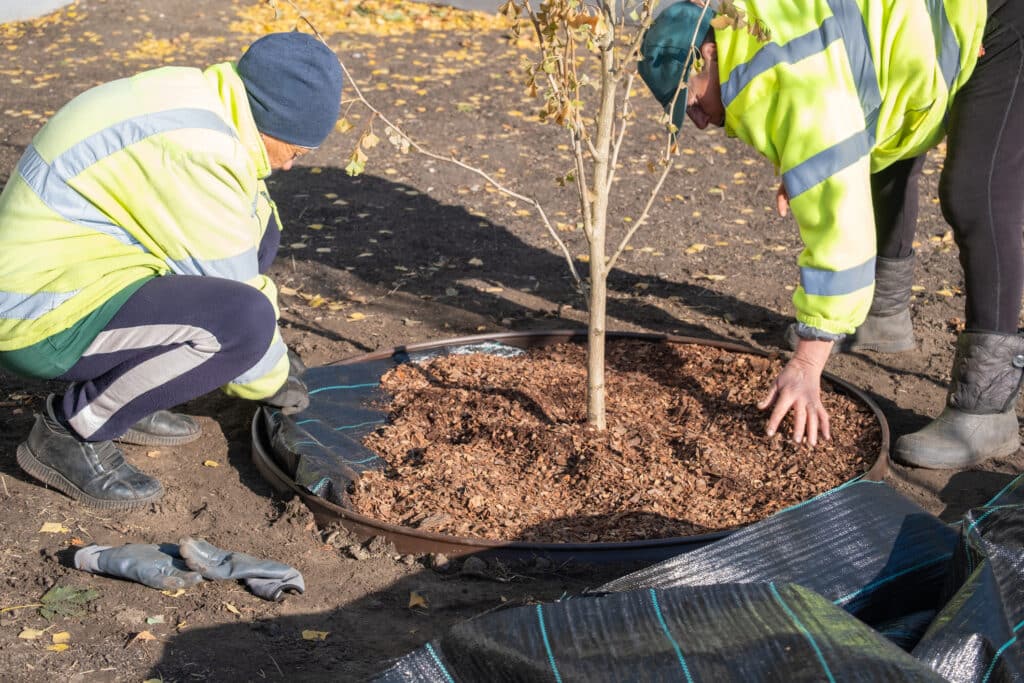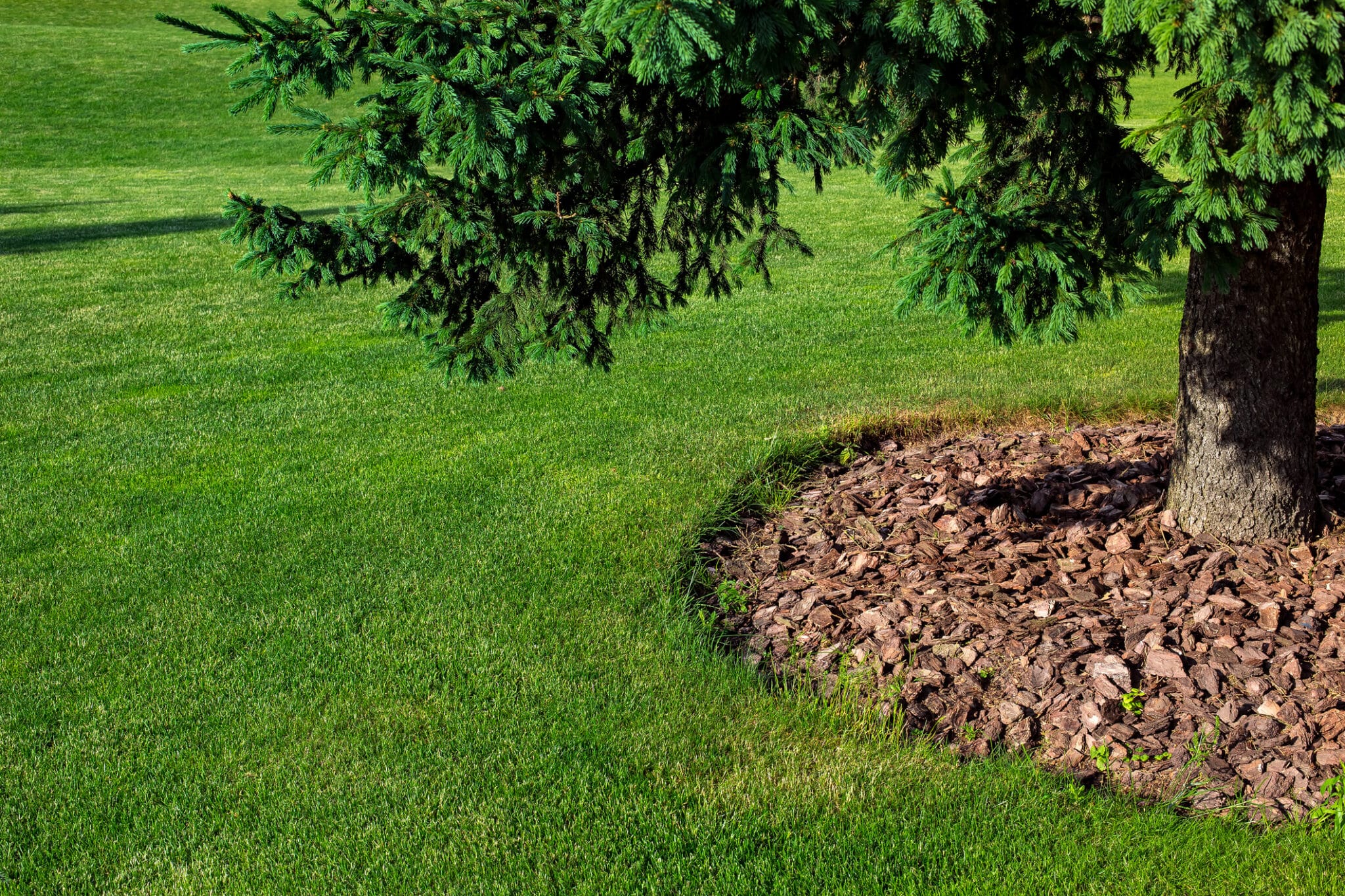Top Benefits of Tree Mulching
Tree mulching offers numerous benefits to keep your trees healthy and thriving. Here are the top benefits:
- Moisture Retention: Mulch keeps the soil moist by reducing water evaporation.
- Temperature Regulation: It insulates roots from extreme heat and cold.
- Weed Suppression: Mulch blocks sunlight, preventing weed growth.
- Soil Health: Organic mulch decomposes, adding nutrients to the soil.
- Erosion Control: It helps prevent soil erosion, especially on slopes.
- Root Protection: Shields delicate roots from damage and compaction.
Mulching is an easy, effective way to boost your trees’ health and improve your landscape year-round.

Do you want your trees to thrive year-round without much hassle? Tree mulching might just be the game-changer your yard needs! It’s not just about making your garden look pretty; mulching provides essential protection and nourishment that helps trees grow stronger and healthier.
Whether you’re dealing with the scorching summers in Dallas or unpredictable weather in Fort Worth, TX, mulching can make a huge difference. Curious about how this simple practice can benefit your trees? Let’s dig into the top benefits of tree mulching.
What is Tree Mulching?
Tree mulching is a simple yet powerful gardening technique that involves placing a layer of material around the base of a tree. This layer, known as mulch, can be made from various materials, both organic and inorganic.
The primary purpose of mulching is to improve soil conditions, retain moisture, and protect the tree’s roots. But it does so much more than that!
Mulching acts as a shield against harsh weather conditions, helps regulate soil temperature, and even enhances the visual appeal of your landscape.
Whether you’re using wood chips, straw, or even gravel, the right mulch can make all the difference in your tree’s health. Now that you know what tree mulching is, let’s explore why it’s so crucial for your trees.
Why is Mulching Important for Trees?
The importance of tree mulching cannot be overstated. Tree mulching is not just an optional step; it’s a vital practice that significantly impacts the health and growth of your trees. Tree mulching serves as a protective barrier for the tree’s roots, helping to retain moisture, regulate soil temperature, and prevent weed growth.
This essential practice improves soil health by adding organic matter as the mulch breaks down, providing essential nutrients to the tree.
The Benefits of Tree Mulching
Mulching offers a wide range of benefits that go beyond basic tree care. Let’s break down some of the key advantages that make mulching an essential practice for any tree lover.
Moisture Retention
One of the biggest benefits of mulching is its ability to retain moisture. In hot climates like those in Dallas and Fort Worth, keeping your trees hydrated can be a challenge. Mulch acts like a sponge, soaking up water and slowly releasing it into the soil, ensuring that your trees have consistent access to moisture.
This reduces the need for frequent watering, saving you time and water costs. Consistent moisture levels are crucial for the tree’s roots to absorb nutrients effectively, promoting healthier growth.
Temperature Regulation
Mulching helps regulate the soil temperature around your trees, which is vital during extreme weather conditions. In the scorching heat of a Texas summer, mulch keeps the soil cooler by providing a barrier between the sun and the ground.
This protective layer shields the roots from overheating, which can cause stress and damage. During colder months, mulch acts as an insulator, trapping heat in the soil and protecting roots from frost damage. This temperature regulation helps trees stay resilient and healthy throughout the year.
Weed Suppression
Nobody likes weeds, especially not your trees. Weeds compete with trees for water, nutrients, and sunlight, and they can quickly take over if left unchecked.
A good layer of mulch suppresses weed growth by blocking sunlight from reaching the soil, making it much harder for weeds to sprout and thrive.
By reducing the competition for resources, mulch allows your trees to grow stronger and healthier without the added stress of battling invasive plants. This also means less time spent on weeding, giving you more time to enjoy your yard.
Soil Health Improvement
As organic mulch breaks down, it adds valuable nutrients back into the soil, improving its overall health. This decomposition process enhances soil structure, promoting better water retention and aeration.
Additionally, the breakdown of organic matter encourages beneficial microbial activity, which plays a key role in nutrient cycling and disease prevention.
Over time, this leads to richer, more fertile soil that supports robust tree growth. Healthy soil means healthier trees with stronger roots and a greater resistance to pests and diseases.
Erosion Control
If you have sloped areas in your yard, you know how quickly soil erosion can become a problem. Mulch helps combat erosion by holding the soil in place, reducing runoff, and preventing valuable topsoil from being washed away during heavy rains.
By stabilizing the soil, mulch preserves the nutrients that your trees need to thrive. This is particularly important in areas prone to heavy rainfall or where the landscape naturally slopes. Mulching not only protects your trees but also contributes to a more sustainable and resilient garden environment.
Root Protection
Tree roots are delicate and can easily be damaged by lawnmowers, foot traffic, and other disturbances. Mulch creates a protective barrier that shields the roots from physical damage, allowing them to grow strong and deep without being disturbed.
This protection is especially important for young trees or those planted in high-traffic areas. By preventing compaction and injury to the roots, mulch helps ensure that the tree’s root system remains healthy and capable of supporting the tree’s growth. Healthy roots are the foundation of a healthy tree.
Aesthetic Enhancement
Beyond the practical benefits, mulching also enhances the visual appeal of your landscape. A well-mulched tree looks neat and tidy, adding a polished touch to your yard.
The uniform appearance of mulch can complement the overall design of your outdoor space, whether you prefer the natural look of wood chips or the clean lines of gravel.
Additionally, mulch helps to define garden beds and pathways, creating a more organized and cohesive landscape. The right mulch can elevate the beauty of your garden, making it a more inviting space to enjoy.
Types of Mulch for Trees
When it comes to tree mulching, not all types of mulch are created equal. The type of mulch you choose can significantly impact the health and appearance of your trees.
Tree mulches can generally be classified into two main categories: organic and inorganic. Each type has its own set of benefits and considerations, depending on your specific needs and the conditions of your yard.
Understanding these differences will help you make the best choice for your trees and ensure your tree mulching efforts yield the best results.
Organic Mulch
Organic mulches are made from natural materials that break down over time, adding nutrients to the soil as they decompose. Common types of organic mulch include wood chips, bark, straw, leaves, and compost, all of which are excellent choices for tree mulching.
These materials not only improve soil health but also help retain moisture and regulate soil temperature, which are critical factors in effective tree mulching.
As organic mulch decomposes, it provides a steady supply of nutrients to your trees, enhancing their growth and resilience.
However, because it breaks down, organic mulch needs to be replenished regularly to maintain its benefits, making it a great choice for sustainable, eco-friendly tree mulching.
Inorganic Mulch
Inorganic mulches are made from materials that do not decompose, such as gravel, stones, rubber, or landscape fabric, and are often selected for tree mulching due to their durability.
These types of mulch are used primarily for their long-lasting nature and low maintenance needs, making them ideal for those looking for a more permanent tree mulching solution. Inorganic mulch provides excellent weed suppression and erosion control without needing to be replaced as often as organic mulch.
However, because they do not break down, they do not add nutrients to the soil, which is an important consideration if soil health is a key goal of your tree mulching strategy.
Inorganic mulch is a good option for those who want a low-maintenance solution, but it may not offer the same soil enrichment benefits as organic tree mulching options.

Best Practices for Mulching Trees
Mulching may seem straightforward, but there are specific techniques and considerations to ensure you’re doing it right.
Proper mulching can make a world of difference in the health and appearance of your trees, while poor practices can lead to problems like root rot or pest infestations. Here’s what you need to know to mulch your trees effectively and avoid common mistakes.
Proper Mulching Techniques
To get the most out of your mulch, it’s essential to apply it correctly. Start by removing any weeds or grass from the area where you plan to mulch. Spread the mulch in a 2 to 4-inch thick layer around the tree, extending out to the drip line (the edge of the tree’s canopy).
Make sure to leave a gap around the trunk, as piling mulch directly against the tree can lead to rot and pest problems.
The goal is to create a “doughnut” shape with the mulch rather than a “volcano.” This allows water to reach the roots without trapping moisture against the tree’s bark.
Common Mulching Mistakes to Avoid
Even with the best intentions, it’s easy to make mistakes when mulching. One common error is applying too much mulch, which can suffocate the roots and create a breeding ground for pests.
Another mistake is piling mulch directly against the tree trunk, which can cause decay and attract insects. Using the wrong type of mulch, such as one that doesn’t break down easily, can also prevent the soil from receiving the nutrients it needs.
Avoid these pitfalls by following the proper techniques and regularly checking the mulch to ensure it’s benefiting your tree.
When to Call Professionals
While mulching is a task that many homeowners can handle on their own, there are times when it’s best to call in the professionals.
If you’re dealing with large trees, steep slopes, or have specific concerns about the health of your trees, a professional arborist can provide expert advice and service.
They can help you choose the right type of mulch, apply it correctly, and ensure that your trees are getting the care they need.
In areas like Dallas, Fort Worth, and Prosper, TX, where tree care can be especially challenging due to weather conditions, professional help can make all the difference.
Seasonal Mulching Tips
Mulching isn’t just a one-time task; it’s something you should consider throughout the year to ensure your trees get the best care in every season. Depending on the time of year, your mulching practices might need a few adjustments to keep your trees in top shape.
Proper seasonal mulching can make a significant difference in how well your trees handle the changing weather conditions. Here’s how to make the most of mulching in different seasons.
Best Times of the Year to Mulch Your Trees
While tree mulching can be done at any time of the year, the best times are typically in the spring and fall. Each season offers unique benefits:
- Spring Mulching: Spring is a critical time for tree growth. Mulching in the spring helps retain moisture as the weather heats up, reducing the need for frequent watering. It also provides a nutrient boost to the soil, supporting the active growth phase of the tree. The mulch acts as a barrier against weeds, giving your trees a head start before the growing season peaks.
- Fall Mulching: Fall mulching is all about preparing your trees for the upcoming winter. By adding mulch in the fall, you insulate the roots against cold temperatures, helping to protect them from frost damage. Additionally, fall mulch helps retain moisture during the drier winter months, preventing the soil from drying out. It’s also an excellent time to replenish the mulch layer, as organic mulches start to decompose and break down over the summer.
By focusing on these key times, you help your trees build resilience and stay healthy through both the scorching summers and the freezing winters.
Adjusting Mulch Depth for Different Seasons
The depth of your mulch layer may need to vary depending on the season. Here’s how to adjust:
- Warmer Months: During the spring and summer, a 2 to 4-inch layer of mulch is usually sufficient to retain moisture and keep the soil cool. This depth helps prevent water from evaporating too quickly and maintains a stable temperature for the roots. It’s important to monitor the mulch regularly, as it may compact or break down, requiring you to add more to maintain the ideal thickness.
- Winter Preparation: As winter approaches, you might want to add a bit more mulch—up to 4 inches or slightly more—to provide extra insulation against the cold. This thicker layer helps to trap heat in the soil and protect the roots from frost. However, be cautious not to over-mulch, especially around the trunk, as this can create excess moisture that may lead to root rot or attract pests.
By adjusting the mulch depth seasonally, you ensure that your trees receive the right balance of protection and nutrients throughout the year. Proper mulching helps maintain the health of the soil and roots, which is essential for the overall well-being of your trees.
Keep Your Trees Thriving with Expert Tree Mulching
Don’t let the Texas heat take a toll on your trees! S&P Tree Service is here to help your trees flourish with professional tree mulching in Dallas, Fort Worth, and Prosper, TX.
Our expert team knows exactly what your trees need to stay healthy year-round. Contact us today to schedule your tree mulching service and give your trees the care they deserve.

FAQs About Tree Mulching
How often should I mulch my trees?
Tree Mulching is typically done once or twice a year, depending on the type of mulch used and the condition of your landscape. For organic mulches, replenish the layer each spring and fall to maintain moisture retention, temperature regulation, and nutrient supply.
What type of mulch is best for young vs. mature trees?
For young trees, organic mulch is best because it breaks down over time and nourishes the soil, which is crucial for establishing their roots. Mature trees can benefit from either organic or inorganic mulch, depending on your aesthetic and maintenance preferences. Organic mulch continues to enrich the soil, while inorganic mulch provides long-lasting weed suppression.
Can I use mulch from my yard for my trees?
Yes, you can use mulch from your yard, such as leaves, grass clippings, or wood chips, as long as it’s free from disease and pests. Yard waste is a cost-effective and environmentally friendly option for Tree Mulching. Just be sure the mulch is free from harmful materials and applied correctly.
How much mulch should I apply around my trees?
Apply a 2 to 4-inch thick layer of mulch around the base of your tree for optimal moisture retention and weed suppression. Be careful not to over-mulch, as too much can suffocate the roots and cause issues like root rot. Always leave a small gap around the trunk to prevent moisture buildup.
What are the signs that I need to refresh the mulch around my trees?
If your mulch has broken down significantly or appears thin, it’s time to refresh it to maintain its benefits. Other signs include increased weed growth, soil drying out quickly, or mulch becoming compacted and hard. Regularly checking and replenishing mulch ensures your trees stay healthy.


